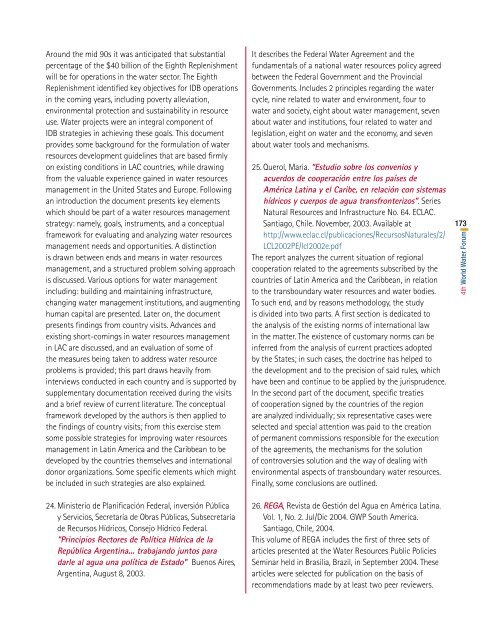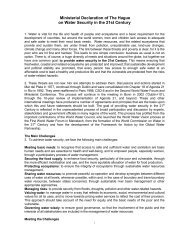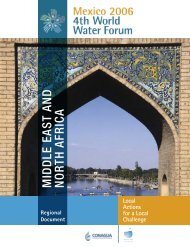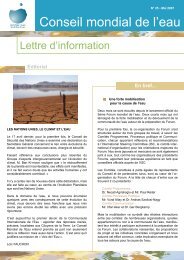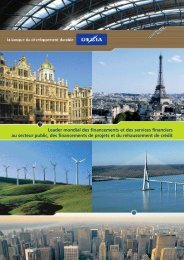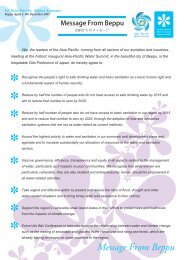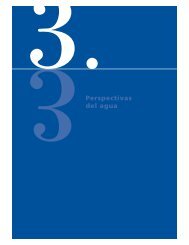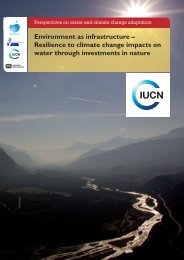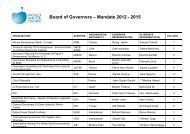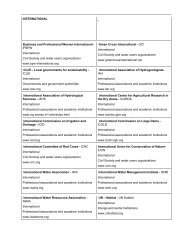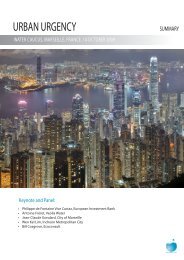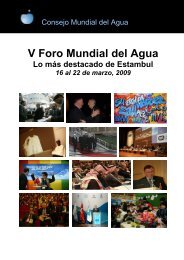Americas ok.indd - World Water Council
Americas ok.indd - World Water Council
Americas ok.indd - World Water Council
You also want an ePaper? Increase the reach of your titles
YUMPU automatically turns print PDFs into web optimized ePapers that Google loves.
Around the mid 90s it was anticipated that substantialpercentage of the $40 billion of the Eighth Replenishmentwill be for operations in the water sector. The EighthReplenishment identified key objectives for IDB operationsin the coming years, including poverty alleviation,environmental protection and sustainability in resourceuse. <strong>Water</strong> projects were an integral component ofIDB strategies in achieving these goals. This documentprovides some background for the formulation of waterresources development guidelines that are based firmlyon existing conditions in LAC countries, while drawingfrom the valuable experience gained in water resourcesmanagement in the United States and Europe. Followingan introduction the document presents key elementswhich should be part of a water resources managementstrategy: namely, goals, instruments, and a conceptualframework for evaluating and analyzing water resourcesmanagement needs and opportunities. A distinctionis drawn between ends and means in water resourcesmanagement, and a structured problem solving approachis discussed. Various options for water managementincluding: building and maintaining infrastructure,changing water management institutions, and augmentinghuman capital are presented. Later on, the documentpresents findings from country visits. Advances andexisting short-comings in water resources managementin LAC are discussed, and an evaluation of some ofthe measures being taken to address water resourceproblems is provided; this part draws heavily frominterviews conducted in each country and is supported bysupplementary documentation received during the visitsand a brief review of current literature. The conceptualframework developed by the authors is then applied tothe findings of country visits; from this exercise stemsome possible strategies for improving water resourcesmanagement in Latin America and the Caribbean to bedeveloped by the countries themselves and internationaldonor organizations. Some specific elements which mightbe included in such strategies are also explained.It describes the Federal <strong>Water</strong> Agreement and thefundamentals of a national water resources policy agreedbetween the Federal Government and the ProvincialGovernments. Includes 2 principles regarding the watercycle, nine related to water and environment, four towater and society, eight about water management, sevenabout water and institutions, four related to water andlegislation, eight on water and the economy, and sevenabout water tools and mechanisms.25. Querol, Maria. “Estudio sobre los convenios yacuerdos de cooperación entre los países deAmérica Latina y el Caribe, en relación con sistemashídricos y cuerpos de agua transfronterizos”. SeriesNatural Resources and Infrastructure No. 64. ECLAC.Santiago, Chile. November, 2003. Available athttp://www.eclac.cl/publicaciones/RecursosNaturales/2/LCL2002PE/lcl2002e.pdfThe report analyzes the current situation of regionalcooperation related to the agreements subscribed by thecountries of Latin America and the Caribbean, in relationto the transboundary water resources and water bodies.To such end, and by reasons methodology, the studyis divided into two parts. A first section is dedicated tothe analysis of the existing norms of international lawin the matter. The existence of customary norms can beinferred from the analysis of current practices adoptedby the States; in such cases, the doctrine has helped tothe development and to the precision of said rules, whichhave been and continue to be applied by the jurisprudence.In the second part of the document, specific treatiesof cooperation signed by the countries of the regionare analyzed individually; six representative cases wereselected and special attention was paid to the creationof permanent commissions responsible for the executionof the agreements, the mechanisms for the solutionof controversies solution and the way of dealing withenvironmental aspects of transboundary water resources.Finally, some conclusions are outlined.1734th <strong>World</strong> <strong>Water</strong> Forum24. Ministerio de Planificación Federal, inversión Públicay Servicios, Secretaría de Obras Públicas, Subsecretaríade Recursos Hídricos, Consejo Hídrico Federal.“Principios Rectores de Política Hídrica de laRepública Argentina... trabajando juntos paradarle al agua una política de Estado” Buenos Aires,Argentina, August 8, 2003.26. REGA, Revista de Gestión del Agua en América Latina.Vol. 1, No. 2. Jul/Dic 2004. GWP South America.Santiago, Chile, 2004.This volume of REGA includes the first of three sets ofarticles presented at the <strong>Water</strong> Resources Public PoliciesSeminar held in Brasilia, Brazil, in September 2004. Thesearticles were selected for publication on the basis ofrecommendations made by at least two peer reviewers.


